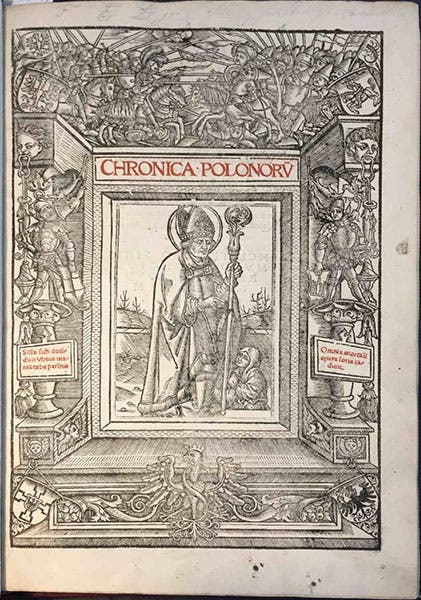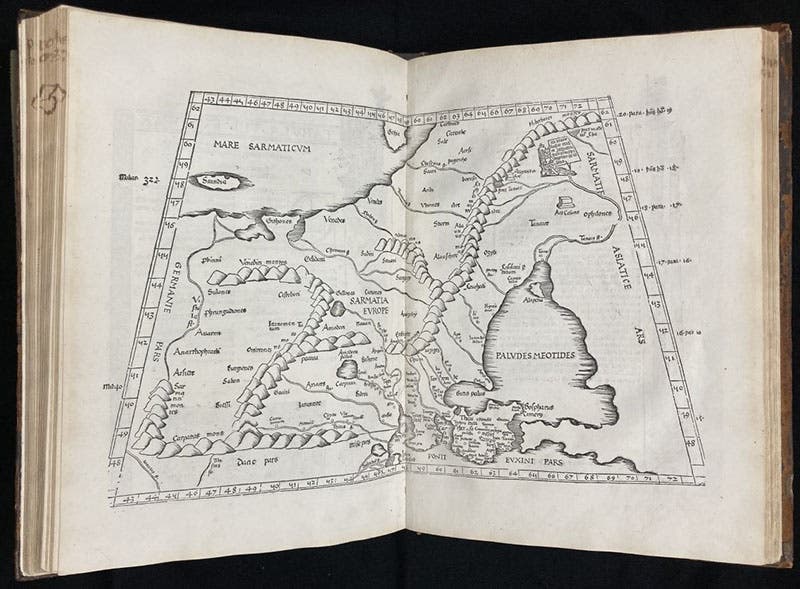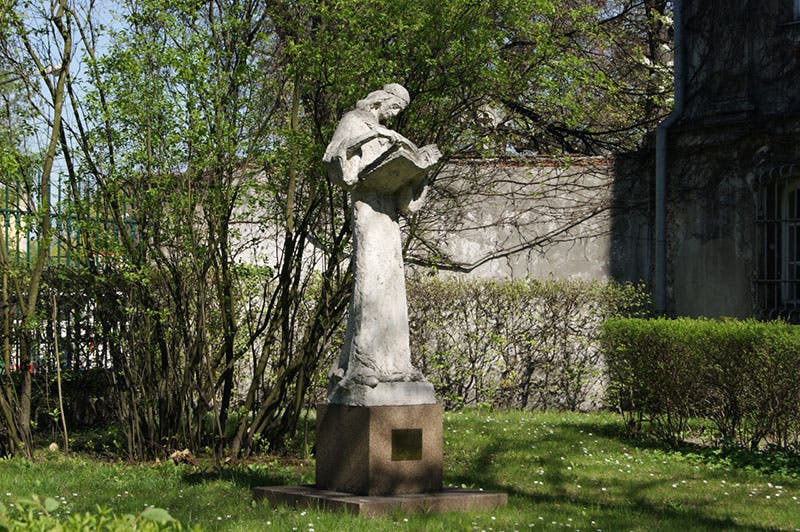Scientist of the Day - Maciej Miechowita
On May 1st, 1514, the Krakow professor and physician Maciej Miechowita (sometimes referred to as Matthew of Miechow) took up a pen and sheaf of paper to inventory his possessions in preparation for a last will and testament. Perhaps he was feeling unwell, perhaps he had recently been reminded of his mortality, or perhaps he was simply a prudent scholar making plans for an inevitable future that would not include him. Whatever the case, like any good Renaissance scholar, he counted his books among his most treasured belongings, and the majority of the twelve tightly-spaced manuscript pages of his household inventory were taken up by a detailed catalog of his library.

Excerpt from Miechowita’s library catalog, where he notes his ownership of a copy of Copernicus’s Commentaliolus with the entry: “sexternus theorice asserentis terram moveri Solem vero quiescere.” (Jagiellonian Library, photo by Karl Galle)
It was a very fine library indeed, and all the more remarkable because Miechowita had reconstructed it following a fire twenty years earlier that destroyed much of his original collection. The hundreds of texts he listed included many of the most famous titles from antiquity and the medieval world. Yet ironically his catalog is best remembered today for a single untitled item near the end, where Miechowita notes briefly that he possesses a “six-folio theorica declaring that the earth moves and the sun is in fact at rest” (second image, above). This remark is the earliest known reference to Nicolaus Copernicus’s heliocentric theory, which Copernicus first described in a short manuscript text now known as the Commentariolus (third image, below).

One of three surviving copies of Copernicus’s Commentariolus manuscript (Austrian National Library, photo by Karl Galle)
Miechowita’s short reference is in fact the only source we have for the circulation of the Commentariolus within Copernicus’s lifetime, because the few remaining manuscripts today are all posthumous copies of one owned by Thaddeus Hagecius many decades later. When Copernicus’s printed book finally appeared in 1543, he remarked that far from rushing to announce his new theory, he had kept it private “not only for nine years but even for four times nine years” (fourth image, below), a reference to advice from the Roman poet Horace, who counseled writers to keep their work private for nine years because hastily published words could never be taken back. The Horace reference would place the genesis of Copernicus’s theory somewhere in the first decade and a half of the 16th century, but we could be no more specific than that until a sharp-eyed Polish historian and paleographer spotted the entry buried in Miechowita’s library catalog.
The value of the Copernicus reference, however, is only one feature of a document that in its own right is one of the most remarkably vivid portraits we have of a late medieval library and household. Earlier library catalogs than Miechowita’s exist, but relatively few of them comprise more than a simple list of texts. Similarly, household inventories from this era are commonly somewhat dry posthumous enumerations by estate executors rather than descriptions from life written by the property owners themselves.
Miechowita’s library catalog, by contrast, goes room by room and wall by wall, describing where each text is located, any other works it is bound with (often including a brief description of the binding), and the nature of the chest, box, or shelf that holds it. Thus, Copernicus’s manuscript is to be found in one room’s “third blackish box made of beechwood” and next to a volume with a white cover containing works by Johannes Regiomontanus, Georg Peurbach, Gerard of Cremona, John Peckham, Masha’allah ibn Athari, and Giovanni Bianchini. Additional mathematical and astronomical works appear in other locations – he owned a particularly fine copy of Claudius Ptolemy’s Almagest, as well as the latest tracts by both critics and proponents of astrology – and he also recorded a huge range of works in medicine, theology, and philosophy, along with unique items like a copy of Vergil’s works “written in my hand as a youth.” Beyond the books, we find descriptions of images on his wall, maps of the Portuguese voyages to India, hourglasses and other instruments for measuring time, sacred relics including “a thin silver ring which is said to have been on the finger of Saint Thomas,” a variety of colorful clothing and tableware, and a large cabinet holding a wooden astrolabe and two swords.
We don’t know for certain the date or even year of Miechowita’s birth, since our only sources on this subject derive from conflicting reports of his age at death. The most plausible of these suggest he was born in either 1453 or 1457, making him about two decades older than Copernicus, but like the latter he began his university studies at Krakow before traveling to Italy for a medical degree. After returning to Poland, he gained financial stability through a canonry in the Catholic church (again like Copernicus) but additionally became a physician to the Polish king as well as a lecturer and administrator at Krakow’s university, where he served eight terms as rector and taught in the medical faculty. By the time he wrote his library inventory, he had published short medical tracts that included the first work on plague to be printed in Poland, and when King Sigismund I traveled for the 1515 Congress of Vienna with Hungarian King Vladislav II and Holy Roman Emperor Maximilian I, a foreign chronicler of the event noted Miechowita’s presence with the Polish king, describing him as “an extraordinary man with as great learning in the healing arts as in prognostication.”
Still greater international fame came in 1517 when he published his Treatise on the Two Sarmatias, Asian and European. Sarmatia was the name of a region from classical geography, roughly equivalent to modern-day Eastern Europe and western Russia from the Baltic to the Black Sea. Ancient authors like Ptolemy had divided it into two sections separated by a long mountain range called the Ripheans (fifth image), but Miechowita pointed out correctly that these mountains did not exist in reality. He declared such information a reflection of tradition rather than experience, and he urged that in the absence of such fixed topographical barriers, the Polish king should emulate Portuguese voyages to the southern hemisphere and launch military campaigns to explore these areas to the north and east. By combining in this manner contemporary polemics on ancient versus modern geographical knowledge along with territorial ambitions by European powers already locked in tense disputes over lands farther east, Miechowita’s tract became a minor bestseller, prompting multiple reprint editions and vernacular translations from Latin into German, Polish, Dutch, and Italian.
The success of his Sarmatia treatise likely helped spur him to finally publish the long work of Polish history that he had recorded in his 1514 catalog as an already completed manuscript. Appearing in 1519, however, his Chronicle of Poland attracted immediate negative reactions from noble and royal figures who felt his decision to cover recent historical events rather than sticking to more ancient and semi-mythological tales did not cast them in a positive enough light. Copies of the work were confiscated and destroyed, giving Miechowita the perhaps unwanted distinction of having written one of the earliest victims of print censorship in Poland. When a second edition of the work appeared in 1521 (sixth image, below), the offending passages had been removed and several more laudatory essays by another writer appended at the end. Nevertheless, despite this brief political rumpus both the Chronicle of Poland and the Treatise on Two Sarmatias continued to be quoted favorably in historical and geographical works for the rest of the 16th century, and he published a final medical work the following year.

Title page of Miechowita’s history of Poland, from the 1521 second edition. (British Library, photo by Karl Galle)
Miechowita did not live to see the short astronomical manuscript from his beechwood box become one of the most earthshaking (so to speak) ideas in the history of science following its 1543 appearance in print. The final pages of the manuscript quire containing his household inventory include a sworn statement from September 7, 1523 – the day before his death – attesting that he, “being sick in body but nevertheless of sound mind,” confirmed the authenticity of his list of possessions and the attached will. He was buried with high honors in the cathedral on the grounds of Krakow’s Wawel Royal Castle, although the exact location of his tomb has been lost.
We have just one portrait of Miechowita, a tiny but lovely illumination showing him at work with one his astrolabes and hourglasses in the background (first image). In Krakow he is also memorialized by a statue on the grounds of the university’s medical school, just outside the medieval city walls. Even in this location he is shadowed by his younger astronomical colleague, as his statue lies on Copernicus Street and only two blocks from the Copernicus Hospital, but he is appropriately shown poring over an especially large specimen from his beloved library (final image, just above).
Karl Galle (karlgalle@aucegypt.edu) is a former fellow at the Linda Hall Library and is currently working on a biography of Nicolaus Copernicus.









